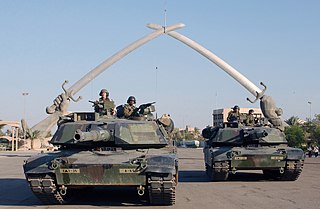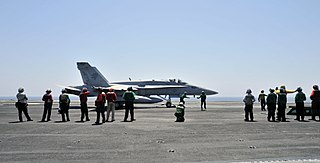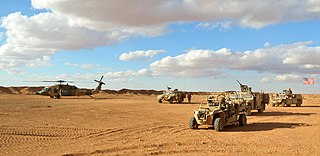
The occupation of Iraq (2003–2011) began on 20 March 2003, when the United States invaded with a military coalition to overthrow Iraqi president Saddam Hussein and his Arab Socialist Ba'ath Party, and continued until 18 December 2011, when the final batch of American troops left the country. While the United States, the United Kingdom, and Australia were the largest contributors to the coalition, 29 other countries, such as Japan, were involved in the Iraq War in a lesser capacity. Additionally, several private military contractors took part in enforcing the occupation.

The following is a timeline of major events during the Iraq War, following the 2003 invasion of Iraq.

After the 2003 invasion of Iraq was completed and the regime of Saddam Hussein was toppled in May 2003, an Iraqi insurgency began that would last until the United States left in 2011. The 2003–2006 phase of the Iraqi insurgency lasted until early 2006, when it escalated from an insurgency to a Sunni-Shia civil war, which became the most violent phase of the Iraq War.

The withdrawal of the United States troops from Iraq began in December 2007 with the end of the Iraq War troop surge of 2007 and was mostly completed by December 2011, bringing an end to the Iraq War. The number of U.S. military forces in Iraq peaked at 170,300 in November 2007.

The Iraq War, also referred to as the Second Gulf War, was a prolonged conflict in Iraq lasting from 2003 to 2011. It began with the invasion by a United States-led coalition, which resulted in the overthrow of the Ba'athist government of Saddam Hussein. The conflict persisted as an insurgency arose against coalition forces and the newly established Iraqi government. US forces were officially withdrawn in 2011. In 2014, the US became re-engaged in Iraq, leading a new coalition under Combined Joint Task Force – Operation Inherent Resolve, as the conflict evolved into the ongoing insurgency.

The Multi-National Force – Iraq (MNF–I), often referred to as the Coalition forces, was a U.S.-led military command during the Iraq War from 2004 to 2009.

Operation Imposing Law, also known as Operation Law and Order, Operation Fardh al-Qanoon or Baghdad Security Plan (BSP), was a joint Coalition-Iraqi security plan conducted throughout Baghdad. Under the Surge plan developed in late 2006, Baghdad was to be divided into nine zones, with Iraqi and American soldiers working side by side to clear each sector of Shiite militias and Sunni insurgents and establish Joint Security Stations so that reconstruction programs could begin in safety. The U.S. military commander in Iraq, David Petraeus, went so far as to say Iraq would be "doomed" if this plan failed. Numerous members of Congress stated the plan was a critical period for the U.S. presence in Iraq.
The U.S.–Iraq Status of Forces Agreement was a status of forces agreement (SOFA) between Iraq and the United States, signed by President George W. Bush in 2008. It established that U.S. combat forces would withdraw from Iraqi cities by June 30, 2009, and all U.S. combat forces will be completely out of Iraq by December 31, 2011. The pact required criminal charges for holding prisoners over 24 hours, and required a warrant for searches of homes and buildings that were not related to combat. U.S. contractors working for U.S. forces would have been subject to Iraqi criminal law, while contractors working for the State Department and other U.S. agencies would retain their immunity. If U.S. forces committed still undecided "major premeditated felonies" while off-duty and off-base, they would have been subjected to an undecided procedures laid out by a joint U.S.-Iraq committee if the U.S. certified the forces were off-duty.

The withdrawal of United States troops from Afghanistan describes the drawdown of United States Armed Forces in the Afghanistan war and the plans after its post-2014 presence when most combat troops had left Afghanistan at the end of 2014.

On 22 September 2014, the United States officially intervened in the Syrian civil war with the stated aim of fighting the terrorist organization ISIS in support of the international war against it, code named Operation Inherent Resolve. The US currently continues to support the Syrian rebels and the Kurdish-led Syrian Democratic Forces opposed to both the Islamic State and Syrian president Bashar al-Assad.

On 15 June 2014 U.S. President Barack Obama ordered United States forces to be dispatched in response to the Northern Iraq offensive of the Islamic State (IS), as part of Operation Inherent Resolve. At the invitation of the Iraqi government, American troops went to assess Iraqi forces and the threat posed by ISIL.

Combined Joint Task Force – Operation Inherent Resolve (CJTF–OIR) is a multinational military formation established by the U.S.-led international coalition against the Islamic State with the stated aim to "degrade and destroy" the organization. Led by United States Army Central (ARCENT), it is composed of military forces and personnel from over 30 countries.
The September 2016 Deir ez-Zor air raid was a series of 37 U.S.-led Coalition airstrikes near the Deir ez-Zor Airport in eastern Syria on 17 September 2016, lasting from 3:55 p.m. to 4:56 p.m. Damascus time in which Syrian Arab Army (SAA) soldiers were killed conducting operations against the Islamic State. Russia reported that at least 62 SAA soldiers were killed, while the Syrian Observatory for Human Rights (SOHR) said at least 80 were killed and 120 wounded. The United States said that the intended target was Islamic State militants and that the attack on Syrian soldiers was due to a misidentification of ground forces while the Syrian and Russian governments claimed that it was an intentional attack against Syrian troops. The attack triggered "a diplomatic firestorm" with Russia calling an emergency United Nations Security Council meeting. Later, the Syrian government called off a ceasefire that had been the result of months of intense diplomatic efforts by the U.S. and Russian governments.
The timeline of the Gulf War details the dates of the major events of the 1990–1991 war. It began with the Iraqi invasion of Kuwait on 2 August 1990 and ended with the Liberation of Kuwait by Coalition forces. Iraq subsequently agreed to the United Nations' demands on 28 February 1991. The ground war officially concluded with the signing of the armistice on 11 April 1991. However, the official end to Operation Desert Storm did not occur until sometime between 1996 - 1998. Major events in the aftermath include anti-Saddam Hussein uprisings in Iraq, massacres against the Kurds by the regime, Iraq formally recognizing the sovereignty of Kuwait in 1994, and eventually ending its cooperation with the United Nations Special Commission in 1998.

The Iraqi conflict is a series of violent events that began with the 2003 American-led invasion of Iraq and deposition of Iraqi president Saddam Hussein, the most recent of which is the ISIS conflict, in which the Iraqi government declared victory in 2017.

Al-Tanf is a U.S. military base in an American occupied part of the Homs Governorate, Syria. It is located 24km west of the al-Walid border crossing in the Syrian Desert. The surrounding deconfliction zone is located along the Iraq–Syria border and the Jordan–Syria border. The garrison is located along a critical road known as the M2 Baghdad–Damascus Highway. The Rukban refugee camp for internally displaced Syrians is located within the deconfliction zone.

The U.S. intervention in the Syrian civil war is the United States-led support of Syrian opposition and Rojava during the course of the Syrian civil war and active military involvement led by the United States and its allies — the militaries of the United Kingdom, France, Jordan, Turkey, Canada, Australia and more — against the Islamic State of Iraq and the Levant (ISIL) and al-Nusra Front since 2014. Since early 2017, the U.S. and other Coalition partners have also targeted the Syrian government and its allies via airstrikes and aircraft shoot-downs.

After the defeat of the Islamic State in Iraq in 2017, Iraq and the United States began discussing the partial withdrawal of American combat troops from Iraq in December 2019. In January 2020, during massive protests in Iraq, and following an escalation of tensions between the United States and Iran, the Iraqi Council of Representatives passed a non-binding measure to "expel all foreign troops from their country," including American and Iranian troops. The American Trump administration ignored the motion, but later began a partial drawdown of forces in March. U.S. combat troops have since accelerated their withdrawal from Iraq.

The Agreement for Bringing Peace to Afghanistan, commonly known as the United States–Taliban deal or the Doha Accord, was a peace agreement signed by the United States and the Taliban on 29 February 2020 in Doha, Qatar, to bring an end to the 2001–2021 war in Afghanistan. Negotiated for the US by Zalmay Khalilzad for the Trump administration, the agreement did not involve the then Afghan government. The deal, which also had secret annexes, was one of the critical events that caused the collapse of the Afghan National Defense and Security Forces (ANDSF). Adhering to the conditions of the deal, the US dramatically reduced the number of US air raids, leaving the ANDSF without a key advantage in keeping the Taliban at bay. This resulted in "a sense of abandonment within the ANDSF and the Afghan population" according to a report by the Special Inspector General for Afghanistan Reconstruction (SIGAR). ANDSF was ill-prepared to sustain security following a US withdrawal, which allowed for the Taliban insurgency, ultimately leading to the Taliban takeover of Kabul on 15 August 2021.














